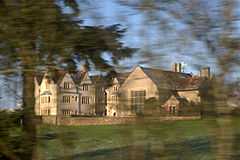Nailsea Court
| Nailsea Court | |
|---|---|
 Nailsea Court from the nearby railway line | |
 Location within Somerset | |
| General information | |
| Architectural style | Jacobean |
| Town or city | Nailsea |
| Country | England |
| Coordinates | 51°24′37″N 2°46′55″W / 51.4102°N 2.7819°W |
| Completed | 15th century |
Nailsea Court in Nailsea, Somerset, England, dates from the 15th century and is a Grade I listed building.[1]
History
Richard Perceval, who was born at Nailsea Court deciphered Spanish documents for Queen Elizabeth about the Spanish Armada invasion plans.[2]
In 1693, the court was purchased by Nathaniel Wade. He supported James Scott, 1st Duke of Monmouth in the Monmouth Rebellion and was defeated at the Battle of Sedgemoor. He was condemned to death at Taunton by Judge Jefferys. After being interviewed by King James, in the Tower of London, Major Wade was pardoned and returned home to Nailsea.[3]
During the 19th century, the court was used as a farmhouse and fell into disrepair. Charles Edward Evans purchased the Court in 1906 and undertook restoration,[4] including the reconstruction of the west wing carried out by Arthur Stratton.[1] The Manorial Tithe Barn behind the house was used during World War I as a convalescent ward for sailors from Naval hospitals and the fireplaces in the main house had brick insets built to reduce their size and conserve coal.[5]
After Evans death in 1944, the court was purchased by the Whitefield family, who turned part of it into flats before it was sold in the 1970s to Mr McGrath.[6]
In the 1990s, the house and grounds were bought by a development company and converted into five private homes.[7]
Architecture
The building consists of a main 3 storey block with two wings with gabled roofs. The porch has a 4-centred arched door opening and a frieze with Greek fret carving.[1]
The interior of the building has been changed many times since its construction. The Langford Room in the south wing has many brought-in features, including panelling from Judge Jeffreys' house at 18 Fore Street, Taunton, an over-mantel together with additional panelling from Field Marshal Sir John Lintorn Arabin Simmons' house at Over Langford Manor (a.k.a. The Old Courthouse or Upper Langford Court, and from which the Langford Room takes its name),[8] a fine plaster ceiling from Ashley Manor, Bristol and a carved frieze. The dining room door, which dates from around 1590, is also known as the "Nailsea door" has large arcaded upper panel with elaborate carving on both sides. The hall has a framed ceiling in 6 bays with chamfered and stopped beams, and a stone fireplace.[1]
There is a variety of stained glass within the building including coats of arms, a sundial and various birds. A window to the west of main range has medieval stained glass including picture of swan ringing a bell, as at the Bishop's Palace, Wells,[1] with others including; peacock, heron, owl, crane and a bird with a bell attached to one leg. Others are representations of; a fox with a bird in its mouth, and an archer drawing his bow.[9]
Gardens
The House is surrounded by 5 acres (2.0 ha) of gardens and approached by a tree-lined drive of mature sweet chestnut, walnut and cherry trees. There is a walled sunken garden and kitchen garden has raised vegetable beds, a glass-house and box knot garden. The old tennis court has been converted to a formal lawn with herbaceous borders.
See also
- List of Grade I listed buildings in North Somerset
References
- ↑ 1.0 1.1 1.2 1.3 1.4 "Nailsea Court". Images of England. English Heritage. Retrieved 2009-04-09.
- ↑ "The Percevals". Nailsea Court. Retrieved 2009-04-09.
- ↑ "The Wades". Nailsea Court. Retrieved 2009-04-09.
- ↑ "The restoration". Nailsea Court. Retrieved 2009-04-09.
- ↑ "Commander Evans". Nailsea Court. Retrieved 2009-04-09.
- ↑ "The Whitefields". Nailsea Court. Retrieved 2009-04-09.
- ↑ "Nailsea Court, Chelvey, BS48". Country Life. Retrieved 2009-04-09.
- ↑ Langford Historical Society book "More Historic Houses of Langford" 2009.
- ↑ "Painted Glass Panes". Nailsea Court. Retrieved 2009-04-15.
Further reading
- Hope Evans, Sylvia; Lewin, F.G. (2001). Peter Wright, ed. Nailsea Court: The Story. Nailsea & District Local History Society. ISBN 978-1-900772-09-9.